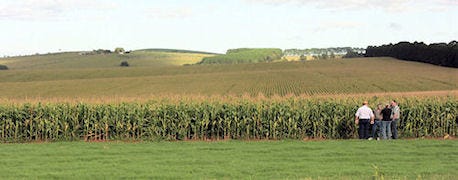July 10, 2013

Agriculture is a constantly changing global business, and with changes come challenges. Senior Editor Bryce Knorr last week made his way to the corn and soybean fields of Brazil to keep tabs on those quick changes and hot topics that keep South American agriculture abuzz. Here's a quick recap of his travels. (Click the blue links to read the entire story.)
More than 6,000 miles away from the U.S., Knorr's Brazilian tour kicked off in Rio, Brazil's second-largest city. As the tour took off to Parana, the number one corn and number two soybean producing state, it became evident both U.S. and Brazilian producers experience similar hurdles.

From environmental regulations to retaining the next generation of farmers, many similarities exist between U.S. and Brazilian ag.
Agriculture is a boom business in Parana, but convincing young people to farm is an uphill battle against the lure of the city -- the same problem faced by several families on the tour.
"We have to make young people realize agriculture is a good business," says Henrique de Salles Goncalves, of SENAR, an organization similar to the Extension service back in the U.S.
Media attention is another challenge. U.S. farmers often are frustrated about how their businesses are portrayed in the media, and here, the producers come under fire from the media in Europe, who believe they're cutting down the Amazon rain forest to grow sugar cane to produce ethanol -- a variant of the food vs. fuel debate.
"It is not true," says Pedro Loyola, an economist with FAEP, the organization lobbying for farmers and their interests in Parana. "We can produce enough sugar cane for ethanol and sugar here in this region. It is not necessary to cut down the rain forest."
Part Two: Environmental Management
The push to stay current with environmental regulations is just as pressing in the U.S. as it is in Brazil, Knorr found during the tour.
On hilly landscape with large groups of trees, Parana offers a decent amount of cropping challenges. With so many hills, there are many waterways, too, and farmers cannot plant within 30 meters of a waterway.
Erosion is a big issue too. And, like the U.S., the solution has been no-till. Parana's farms are routinely 100% no-till, with soybeans, corn, edible beans, wheat and small grains poking up through the thin, red soil.
In Parana, soybeans are the preferred crop for farmers, but corn is on the way up, despite its distinct harvesting and marketing challenges.
Brazilian farmers note that the corn must be harvested with high moisture content – typically 26% -- for a reason that limits how they can market the crop. Farmers typically forward price a significant percentage of their soybean crop before harvest, but buyers are reluctant to contract corn due to quality problems, including toxins that are more likely the longer the crop is left in the field.
Further, corn takes a lot of fertilizer in their thin, red soils, and Brazil must import 70% of its nutrients. Transportation to market is also limited, but Parana is closer to many domestic markets than farmers in other parts of the country, making it easier to grow corn.
"It's starting now, but it's only just starting," says farmer Albertine Perez of corn's export growth. That likely won't be true for long, Knorr comments.
You May Also Like




